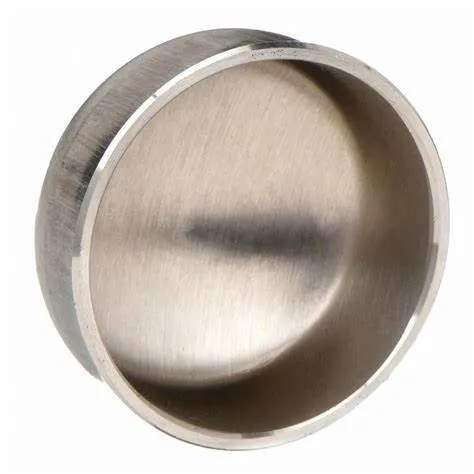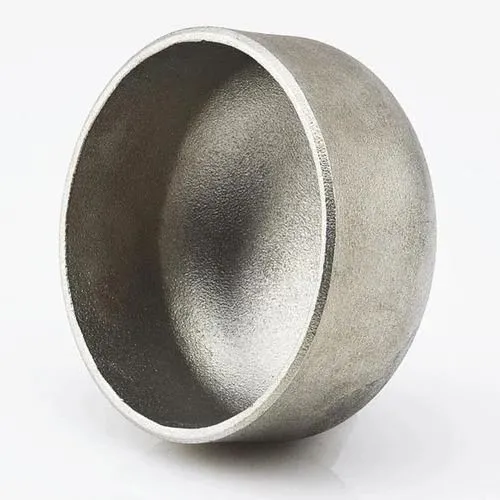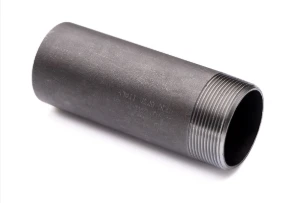JIS B2311 нь гагнуурын хоолойн холбох хэрэгсэл, түүний дотор хоолойн системд хэрэглэгддэг таглааг хамардаг Японы аж үйлдвэрийн стандарт юм. Тулгаа-гагнуурын таг нь хоолойн төгсгөлийг хааж, гоожих, бохирдохоос сэргийлж битүүмжлэх зорилготой. JIS B2311 тулгаа гагнуурын тагны танилцуулгыг энд оруулав.
- 1. JIS B2311 Standard:
- - JIS B2311 стандарт нь хоолойн систем дэх тулгаа гагнуурын холбох хэрэгсэл, түүний дотор тагны загвар, хэмжээ, материал, үйлдвэрлэл, туршилтад тавигдах шаардлагыг тодорхойлдог.
- - Стандарт нь JIS стандартын дагуу үйлдвэрлэсэн таг нь чанарын стандартыг хангаж, бусад хоолойн эд ангиудад нийцэж байгааг баталгаажуулдаг.
- 2. Тулгасан гагнуурын малгай:
- - JIS B2311 стандартын дагуу гагнуурын таг нь хоолойн төгсгөлийг найдвартай таглаж, битүүмжлэх зориулалттай холбох хэрэгсэл бөгөөд хоолойн системийг хамгаалах, бүрэн бүтэн байдлыг хангах боломжийг олгодог.
- - Хоолойн төгсгөлийг бүрмөсөн эсвэл түр хугацаагаар хаах шаардлагатай тохиолдолд таглааг гоожиж, бохирдохоос урьдчилан сэргийлэх, эсвэл системийг өнгөлгөө өгөх зорилгоор ашигладаг.
- 3. Материал ба хийц:
- - JIS B2311 стандартын дагуу гагнуурын таглааг янз бүрийн хэрэглээний шаардлагад нийцүүлэн нүүрстөрөгчийн ган, зэвэрдэггүй ган, хайлш ган гэх мэт төрөл бүрийн материалаар хийх боломжтой.
- - Эдгээр таг нь хоолойн төгсгөлд гагнуурын үед бат бөх, гоожихгүй холболтыг хангахын тулд стандартчилагдсан барилгын аргыг ашиглан үйлдвэрлэдэг.
- 4. Хэрэглээ ба ашиг тус:
- - Тулгасан гагнуурын таг нь газрын тос, хий, химийн процесс, ус цэвэрлэх байгууламж гэх мэт янз бүрийн салбарт ашиглах боломжтой бөгөөд хоолойн төгсгөлийг найдвартай таглах шаардлагатай байдаг.
- - Бүрхүүл нь хоолойн төгсгөлийг хүрээлэн буй орчны хүчин зүйлээс хамгаалж, бохирдлоос сэргийлж, хоолойн системийн цэвэр, бүрэн бүтэн байдлыг хадгалахад тусалдаг.
- 5. Суурилуулалт ба гагнуур:
- - Тулгасан гагнуурын тагийг суурилуулахдаа нягт, битүүмжлэлгүй битүүмжлэлийг хангахын тулд угсралтын зөв дадлага, тухайлбал зөв тэгшлэх, хоолойн төгсгөлийг бэлтгэх, гагнуурын техникийг хийх нь чухал юм.
- - Гагнуур нь хоолойд тагийг бэхлэх нийтлэг арга бөгөөд систем доторх даралт, температурын өөрчлөлт, шингэний урсгалыг тэсвэрлэх чадвартай, найдвартай, байнгын хаалтыг хангадаг.
- Дүгнэж хэлэхэд JIS B2311 тулгаа гагнуурын таг нь хоолойн төгсгөлийг найдвартай битүүмжлэх, хамгаалахын тулд хоолойн системд ашиглагддаг чухал бүрэлдэхүүн хэсэг юм. Эдгээр таг нь хоолойг хаах, хамгаалах шаардлагатай үйлдвэрлэлийн хэрэглээний чанар, найдвартай байдал, нийцтэй байдлыг хангах стандарт шаардлагад нийцдэг.
What Is a Butt Welding Cap and How Is It Used in Industrial Piping?
In industrial piping systems, end-of-line sealing and branch closures require robust solutions. A butt welding cap serves as a critical component for terminating pipes securely. By providing a seamless, welded closure, this fitting maintains system integrity, prevents leaks, and supports compliance with industry standards.
What Is a Butt Welding Cap?
A butt welding cap—also called a pipe end cap or buttweld end cap—is a round fitting designed to close off the end of a pipe. It’s manufactured to match the pipe’s outer diameter and schedule, with either a hemispherical or flat face. To install, both the pipe end and cap are beveled to form a V‑groove, enabling full‑penetration, fusion welds. Common materials include carbon steel, stainless steel, nickel alloys, and other engineered grades, chosen to satisfy pressure, temperature, and corrosion‑resistance requirements.
How Is Butt Welding Cap Used in Industrial Piping?
Butt welding caps find application across oil & gas, petrochemical, power generation, water treatment, and general process industries for both permanent and temporary closures. During hydrostatic testing, technicians install caps to seal off sections of piping while monitoring for leaks. In new construction or retrofit projects, caps terminate branch lines, future tie‑in spools, or dead‑end mains until system expansion. Welders prepare each joint by cleaning and beveling surfaces, aligning the cap precisely, and executing a root pass followed by filler passes per the qualified Welding Procedure Specification (WPS). Post‑weld heat treatment and non‑destructive examination (NDE)—such as radiography or ultrasonic testing—verify weld integrity and compliance with ASME B16.9 and related standards. Additionally, temporary caps enable safe isolation during maintenance, allowing for segment testing and dewatering under regulatory protocols.
Benefits and Best Practices
Butt welding caps offer a smooth‑bore transition that minimizes flow disruption and stress concentration. Their full‑penetration welds deliver exceptional structural strength and leak resistance. To optimize performance, engineers should:
Select caps with matching material grades and wall thicknesses
Adhere to proper bevel angles and joint fit‑up tolerances
Follow qualified WPS protocols rigorously
Consider cladding or protective coatings in corrosive environments to extend service life
Regular inspection and thorough documentation ensure long‑term reliability and safe operation under demanding conditions.
Butt welding caps are indispensable components for achieving durable, leak‑proof pipe terminations in a wide range of industrial applications.
Butt Welding Cap FAQs
What is a butt welding cap?
|
What materials are commonly used?
|
What standards govern butt welding caps?
|
How are butt welding caps installed?
|
Where are butt welding caps typically used?
|
What are the advantages of threaded caps?
|
















